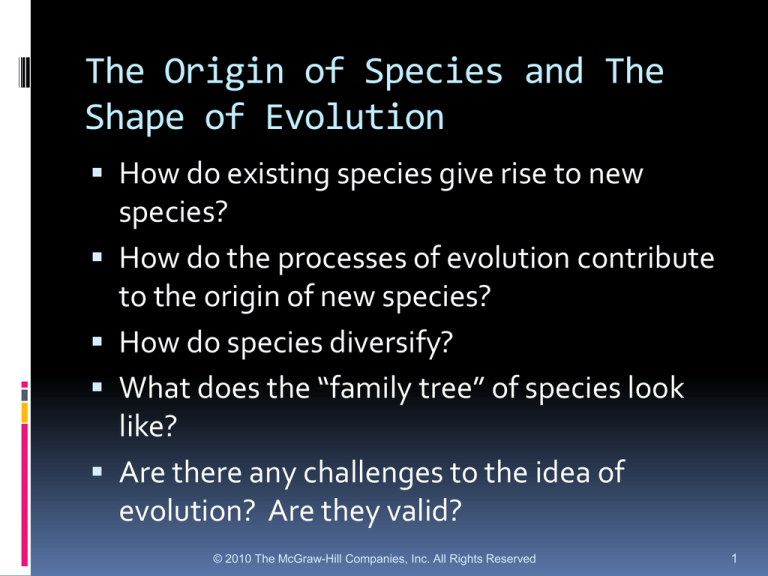
The Origin of Species and The
Shape of Evolution
How do existing species give rise to new
species?
How do the processes of evolution contribute
to the origin of new species?
How do species diversify?
What does the “family tree” of species look
like?
Are there any challenges to the idea of
evolution? Are they valid?
© 2010 The McGraw-Hill Companies, Inc. All Rights Reserved
1
The Origin of Species and The
Shape of Evolution
New Species
The origin of new species is the evolution of any
differences between populations that prevent the
production of fertile offspring.
© 2010 The McGraw-Hill Companies, Inc. All Rights Reserved
2
The Origin of Species and The Shape
of Evolution
© 2010 The McGraw-Hill Companies, Inc. All Rights Reserved
3
Reproductive Isolating Mechanism
Any difference that prevents the production of fertile
offspring between members of two populations.
Hominins
Modern human beings and our ancestors, generally
defined as the primates who habitually walk erect.
Speciation
The evolution of a new species.
Macromutations
Mutations with extensive and important phenotypic
results.
© 2010 The McGraw-Hill Companies, Inc. All Rights Reserved
4
The Origin of Species and The
Shape of Evolution
Adaptive Radiation: The Evolution of Life’s
Diversity
For a potential new species to persevere, it must
survive the adaptive trials of natural selection.
© 2010 The McGraw-Hill Companies, Inc. All Rights Reserved
5
Adaptive Radiation
The evolution and spreading out of related species
into new niches.
Generalized
Here, species that are adapted to a wide range of
environmental niches.
Specialized
Here, species that are adapted to a narrow range
of environmental niches.
© 2010 The McGraw-Hill Companies, Inc. All Rights Reserved
6
Nocturnal
Active at night.
Prosimian
A primate with primitive features, most closely
resembling the ancient primates.
Diurnal
Active during the day.
Arboreal
Adapted to life in the trees.
© 2010 The McGraw-Hill Companies, Inc. All Rights Reserved
7
The Origin of Species and The
Shape of Evolution
The Shape of the Family Tree
The evolution of life on earth cannot be depicted
as a ladder or a chain, nor is it a gracefully
branching tree.
Instead, it is a “luxuriant bush,” more complex
than we will probably ever know.
© 2010 The McGraw-Hill Companies, Inc. All Rights Reserved
8
The Origin of Species and
The Shape of Evolution
© 2010 The McGraw-Hill Companies, Inc. All Rights Reserved
9
Darwinian Gradualism
The view, held by Darwin, that evolution is slow
and steady with cumulative change.
Microevolution
Evolutionary change within a single species
through time.
Macroevolution
The branching of new species from existing
species.
© 2010 The McGraw-Hill Companies, Inc. All Rights Reserved
10
Oscillating Selection
Adaptive variation around a norm, rather than in
one direction, in response to environmental
variation in a species’ habitat.
Punctuated Equilibrium
The view that species tend to remain stable and
that evolutionary change occur fairly suddenly
through the evolution of new species branching
from existing ones.
© 2010 The McGraw-Hill Companies, Inc. All Rights Reserved
11
The Origin of Species and The
Shape of Evolution
Evolution Questioned: The Pseudoscience of
“Scientific Creationism”
Scientific creationism is a pseudoscience, a
testable set of ideas that even in the face of
contrary evidence is accepted on faith.
© 2010 The McGraw-Hill Companies, Inc. All Rights Reserved
12
Pseudoscience
Scientifically testable ideas that are taken on faith,
even if tested and shown to be false.
Scientific Creationism
The belief in a literal biblical interpretation regarding
the creation of the universe, with the connected belief
that this view is supported by scientific evidence.
Intelligent Design
The idea that an intelligent designer played a role in
some aspect of the evolution of life on earth, usually
the origin of life itself.
© 2010 The McGraw-Hill Companies, Inc. All Rights Reserved
13
The Origin of Species and The
Shape of Evolution
Summary
The evidence of evolution is overwhelming. We
are still examining the specific details of
evolutionary theory, but the idea of evolution and
our knowledge of the essential processes involved
are hypotheses that have passed numerous
scientific tests and failed none.
© 2010 The McGraw-Hill Companies, Inc. All Rights Reserved
14






